From - BBC World News
By - Sophie Hardach
Edited by - Amal Udawatta
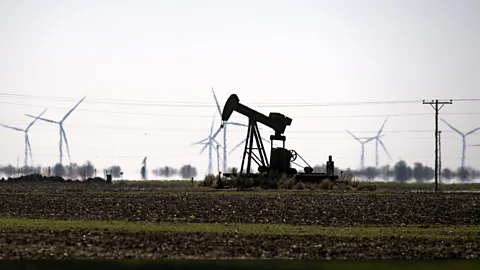
US President Donald Trump says that wind farms harm birds and whales. Scientists weigh wind power's impacts on wildlife against those of oil and gas.
Aspen Ellis, a seabird biologist at University of California, Santa Cruz, spent a decade doing field work on remote islands off the coast of the United States. She often lived for months amongst thousands of birds, becoming so immersed in their ways that she even learned to tell which predators were nearby from the birds' calls. But as she added her observations to 40 or 50 years of previous research on these colonies, she noticed a worrying pattern.
"Again and again, I just found myself logging the impact of climate change over time," she recalls, from rising sea levels that threatened breeding colonies, to fish moving to cooler areas and leaving seabird chicks starving. "Without addressing this larger issue of climate change, the seabird conversation work we were doing wasn't sufficient to save those populations," she adds. She decided to change focus – and today, studies ways to make clean-energy offshore wind farms safer for birds.
The impact of energy production on wildlife has come into the spotlight again amid US President Donald Trump's plan to pivot the country's supply from renewables such as wind, to oil and gas. In his first days in office, Trump revoked former-president Joe Biden's ban on new offshore oil and gas drilling. "We will drill, baby, drill," Trump promised when he was inaugurated, while putting the brakes on the expansion of wind farms. One of his arguments is that wind farms harm birds and whales. His executive order halting offshore wind farm development cited the importance of marine life as one of the reasons for the decision.
While wind farms can have some adverse effects on local wildlife in the habitats where they are sited, including through noise, Ellis and other scientists specialising in the environmental impact of wind farms challenge the claim that wind power is more damaging to wildlife than fossil fuel extraction. They describe wind energy as a powerful and necessary weapon against climate change, arguing that its impact on wildlife can be understood, managed and reduced. They contrast this with the existential risk posed by fossil fuels driving global warming – along with the ongoing noise and pollution from oil and gas production.
The debate is highlighting one of the most challenging conundrums facing renewable energy projects around the world – to what degree must they balance the impact they can have on local environments with the global effects of climate change? And how do those wind-power related impacts compare with the local effects of oil and gas drilling?
Weighing up the threats
"Fossil fuels, and their effect on climate change, outweigh everything," says Beth Scott, a professor in marine ecology at the University of Aberdeen in Scotland, a nation that has become a wind energy powerhouse. "Climate change is by far, by far the worst enemy, to all wildlife, and humans." Speaking from Aberdeen, she points to her window, at a brewing storm due to batter Scotland later in the day. It's too soon to say if this particular storm has been made stronger by climate change, but the overall picture is clear – extreme weather is "only going to get worse" in a warmer world, she says.
Scott and her colleagues are studying the impact of wind power on the marine ecosystem. While that impact exists – more on it later – she also describes wind power especially useful tool in the switch to renewable, climate-friendly energy because it can be built quickly and at scale.
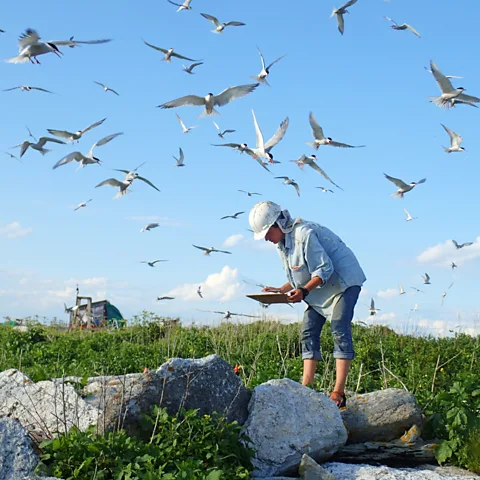 Zhongyong Fan
Zhongyong Fan"Once you start construction, in less than two years, you can build a 2GW [offshore wind] farm – the equivalent of a nuclear plant," Scott says. Nuclear power plants can take over a decade to construct. "So, in terms of rapid response to climate change, there's that."
Ellis also sees wind power as especially promising. "There is a lot of consensus [among seabird experts] on the need to move from traditional energy sources to a renewable energy framework, and offshore wind has a really big potential to do that," she says. "We're seeing the industry really boom very quickly, there's a lot of interest in that internationally, there's a lot of capacity for it internationally."
Finding the right location
Wind farms, both on land and in the sea, do pose a risk to birds, however, including habitat loss and collisions with the turbine or their blades. In Scotland, for example, the northern gannet and the black-legged kittiwake are considered at high risk of collision with wind farms.
Seabirds may also suffer indirect effects, for example if they change their routes to avoid wind farms, and then spend more time and energy finding food. How much seabirds avoid wind farms, and how this affects them, may vary significantly and is still subject to ongoing research. Some, such as the red-throated diver, have been reported to avoid wind farms, while others, such as large gulls, have a mixed response to them, research suggests. Others again, such as cormorants, seek out wind farms to forage and roost there. (Read more about how wind farms can be made safer for birds.)
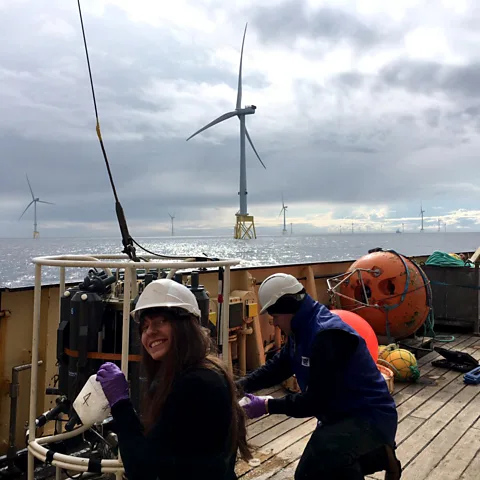 PELAgIO NERC ECOWind project
PELAgIO NERC ECOWind projectIn Scotland, Scott and other scientists are conducting wide-ranging research on the impact of wind farms on the whole food web, including on plankton, using ocean robots and other instruments. Wind power does alter the ecosystem, Scott says, but the impact is not necessarily always negative. Research tracking seals suggests that they now use wind farms as hunting grounds to forage for fish gathering around the turbines, for example, with one seal's tracks showing how the animal made its way through the farm and stopped at different turbines to snack.
Decades of research from around the world suggests that oil production affects birds, whales and other wildlife in many different ways. Apart from the climate factor, there is the risk of oil spills as well as smaller, chronic leaks, scientists say, which can harm seabirds, whales, dolphins and other wildlife. Dolphins exposed to the Deepwater Horizon oil spill in the Gulf of Mexico in 2010, for example, suffered health problems including chronic lung disease and abnormal hearts, research has shown.
Kaitlin Frasier, an associate research scientist at Scripps Institution of Oceanography at University of California, San Diego, and other researchers have studied how the unprecedentedly large and deep offshore oil spill has impacted different whale and dolphin species in the long term. They used acoustic sensors to record the clicks emitted by the animals, and from that, estimated their population density in the area. They found that a decade after the spill, seven of eight monitored species groups had declined, including sperm whales (by up to 31%) and beaked whales (up to 83%).
But the sensors also picked up on something else, which you can listen to in the recording below: deafening blasts from oil exploration in the Gulf of Mexico.
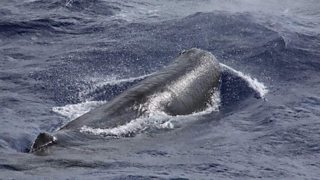
"[The Gulf of Mexico] is a really noisy area because of all of the surveys that are associated with drilling, they do these seismic surveys that generate a whole lot of noise as they are looking for the oil pockets and understanding how the oil is moving," says Frasier.
Noise pollution at sea
The noise from oil and gas is largely from seismic surveys deploying airguns, which are towed behind ships and blast compressed air through the water every 10 seconds, Frasier says. "They're doing this in deep water, 1,000m (3,280ft) or more, and it's really low frequencies, so theses sound waves travel really far in deep water," she says. The sound is so powerful that "you can hear it all the way across the Gulf of Mexico".
"So, they're surveying off of Texas, you'll hear it off of Florida, you'll hear it in Mexican waters. There's no way to escape that sound," she says.
For whales, dolphins and other marine mammals that rely on sound and echolocation to find their food in dark and murky water, such loud and sudden underwater noise can be deeply disorienting, equivalent to being blinded, as well as being very distressing for them, research has shown.
"If you think about a sperm whale, one of the species in our study, a third of the body of the animal is a sound-production device. That's how important sound is to the animal. Their whole life is centred around the use of sound," says Frasier.
In the Gulf of Mexico, the noise from the airguns as well as vessels may be making it harder for whales and dolphins to forage for food, Frasier suggests. The oil and gas industry, however, maintains that there is no evidence that airgun noise injures or harms marine life, an assertion that environmental groups dispute.
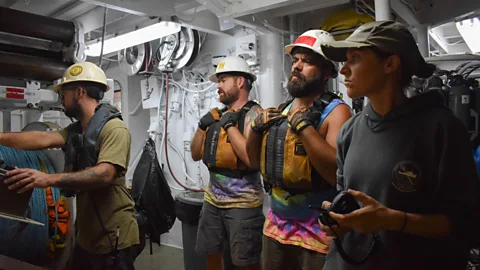 Scripps Machine Listening Lab, University of California San Diego
Scripps Machine Listening Lab, University of California San Diego"It's not that we think those sounds are directly killing whales, but those whales use sound in their daily life to find food, to communicate with each other," Frasier says. "Imagine if a light was being blasted into your face every 10 seconds – that would be disruptive as you're trying to go about your day."
Wind farm construction also involves noise, for example during surveying but also when the pile is hammered into the seabed. Studies have shown that seals and harbour porpoises are affected by the noise from pile-driving, causing them to flee for several miles and affecting their ability to feed.
But Frasier highlights that with oil and gas, the surveys happen over a longer time period, not just before but also during extraction.
"We see it in all of our recordings," she says of the oil-related noise, which she describes as a constant backdrop to the whale sounds. "It's very heart-wrenching to listen to."
By comparison, evidence from European offshore wind farms suggests that loud noise from wind farm construction tends to be more temporary and containable, as it happens during the pile-driving phase. In Europe, some countries such as Germany now legally oblige offshore wind farm developers to place devices called bubble curtains around the construction sites to buffer such pile-driving noise, and protect porpoises and other marine animals. (Read about how bubble curtains work, and their effect on wind farm noise).
Once the wind farm is in place, it can keep spinning for decades and then be replaced with new turbines on the same land, whereas oil production moves on once one site is exhausted. There is, however, also ongoing noise in offshore wind farms from the spinning turbines and the supply and maintenance vessels. Ship noise – whether from such maintenance vessels, or shipping generally – can in turn affect marine mammals such as harbour porpoises.
The onshore effects of oil, gas and wind
Liba Pejchar, a professor and conservation biologist at Colorado State University, and her team have compared the effects of inland wind energy and oil and gas on ecosystems in Colorado and neighbouring Wyoming. These states are home to wind farms, as well as oil and gas fields. One of the aspects they studied was habitat loss and fragmentation, meaning, wildlife habitat being lost or broken up through roads as well as the turbines or oil and gas fields themselves.
They found that both onshore wind farms and oil and gas production, caused habitat loss. However, "we found overall that wind energy resulted in less habitat fragmentation than oil and gas and especially, less impacts over the long term", she says. "In the near term, the impacts were often somewhat equivalent, but wind energy is a renewable resource, so once you put in the turbines, they continue to harness that energy for decades to come. Whereas oil and gas have to keep moving, and so those impacts just getting compounded across the landscape."
While wind power hazards for birds, such as collisions, are well-known, preliminary research by Pejchar's team suggests oil and gas production can also negatively affect birds and their habitat, and for example, have impacted ferruginous hawks in Wyoming.
Like the other scientists, Pejchar also highlights how climate change, driven by fossil fuels, is already changing the environment. "There's a higher frequency of these large, catastrophic fires in Colorado in particular," she says. "Sometimes wildlife can benefit from fire, it's a natural form of disturbance, but the scale of these fires and the intensity and frequency – there could be complete state changes, where forests can no longer be sustained because fire is moving through them on such a regular basis. So that's going to have a huge impact on wildlife communities."
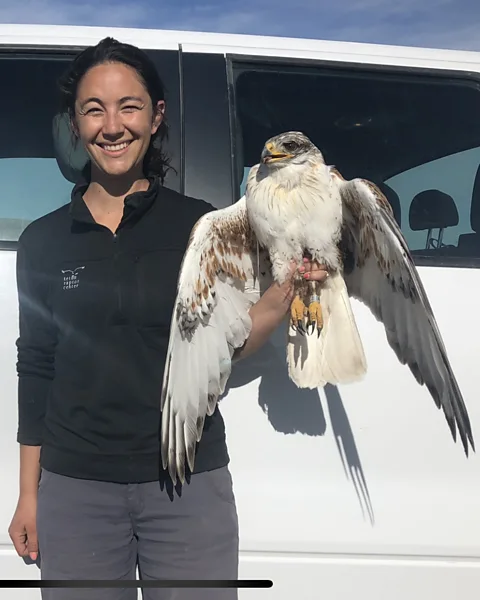 Bryan Bedrosian
Bryan BedrosianBoth industries are taking steps to reduce the effect their activities have on the local environments where they operate.
In a 2022 study co-led by Ellis, an international group of scientists and also conservation organisations such as American Bird Conservancy developed a process that allows wind farm developers to identify and minimise the risks to seabirds. They recommended measures to reduce or offset the impact that included choosing sites that are less in the way of seabirds' known flight routes or habitats; wind farm developers building alternative nesting sites; and developers funding conservation programmes to boost the species in other habitats.
"Seabirds are a great case study for this [process], because we have a lot of data about many of these species," Ellis says. In addition, "seabird conservation is very well understood", she says, both in terms of specific threats to seabirds, such as predators and invasive plants, and also in terms of how to effectively address those threats, for example by removing predators such as rats, and clearing invasive plants. The assessment process outlined in the study could then also be used to reduce the impact of wind power on other species, such as bats and whales, with measures that are appropriate for them, she says.
Regarding the environmental impact of fossil fuel extraction, some of the most important measures have aimed at reducing oil spills and chronic oil pollution, which can be catastrophic for birds and other wildlife. Monitoring of beached, oiled birds in Europe's North Sea has revealed a sharp decline in the rate of oiled birds, suggesting a decrease in oil pollution and spills as a result of measures such as requiring oil tankers to have double hulls.
But the attempts to lessen the local effects of energy infrastructure do little to address the wider context of climate change, the threat of which has led to international agreements to phase down fossil fuels. Carbon emissions from the burning of fossil fuels are leading many parts of the world to feel the effects of global warming.
And these are beginning to affect the environments where fossil fuels are extracted too. The Gulf of Mexico, for example, has been in the grip of a climate-change-fuelled marine heatwave, which can make hurricanes more intense.
Alongside the carbon dioxide released from the burning of fossil fuels, the intensity of extracting the oil in the Gulf of Mexico has an additional climate impact from the release of large quantities of methane – an even more potent greenhouse gas than carbon dioxide over a 20 year period.
Although the global supply of renewable power is surging, and demand for oil, gas and coal are all predicted to peak this decade, the race to build energy infrastructure that doesn't harm wildlife looks set to be a challenge for years to come.
How the energy industry responds will be felt in habitats around the world.
--
Comments
Post a Comment